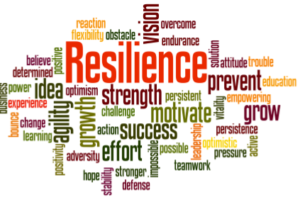The Ability to Recover Quickly From Difficulty

Does this picture bring back memories? As we watch our children grow up, most parents can recall countless times when they were exposed to life’s harsh realities. From skinning their knees, to feeling left out at the lunch table, or being dumped by a boy/girlfriend, our kids will experience their fair share of situations that test their resiliency. While we can’t do much to change the challenges they face, we can prepare them to get back on their feet by encouraging the development of their resiliency skills.
Contrary to a popular misconception that resiliency is an innate skill, that you are born with, research tells us that anyone can learn resiliency skills. Resilience research proves that resilience is not a phenomena, but quite commonplace. The skills do not come from rare and special qualities, but from ordinary normative resources in the minds, brains, and bodies of children, through their families and relationships and in their communities. Resilience theory believes that the ups and downs of life are to be embraced, not avoided, and that coping with risk and bouncing back from adversity are good for us.
What does that mean for you as parents? Many resources are available online that provide a comprehensive guide to enhance resiliency in children. The breadth of resources can feel overwhelming, so let’s begin by taking a look at a few basic ideas you might not have even realized support the development of resiliency in your kids.
Ultimately, modeling resilient behavior is one of the best ways to instill resilience in your children.
Creating Structure
- Chaotic environments are not helpful for encouraging problem-solving skills. Chaos and clutter can distract a child from the task at hand, especially if it is challenging. Keeping your home organized and as neat as possible is more conducive to focusing your child on developing a plan to overcome an adversity.
- Rules should be designed to create boundaries, expectations and structure. An important point in setting rules is to explain to your children why you have decided on a particular rule. Knowing the reasons for a rule can make it much more likely your child will follow it. Children follow rules all day that structure their life at school so it can be possible at home, too!
- Having a predictable schedule can alleviate the worry that comes from not knowing what’s going to happen next. When there’s a change in routine, it can be helpful to give children as much advance notice as possible. This eliminates one common area of disagreement- “you never told me!”- and encourages flexible adjustment to change.
- Structure also lets them know that someone is in control. As much as they may try to rebel against it, knowing someone is in charge can be reassuring, especially for anxious children.
Providing Support
- It sounds cliché to say, “listen to your kids,” but many children have the perception that what they say or think is totally unimportant to the adults in their lives. While that may be true, it’s valuable to listen to your child’s point of view. If they tend to ramble on, find a logical place to interrupt and then summarize what you’ve heard them say. Don’t try to fix problems they may bring up! Take a few minutes and ask them to come up with at least 3 solutions themselves – good, bad, or indifferent. Then give each solution pluses and minuses; this can make it easier for your child to understand what may work best with the least downsides.
- Validate and name their feelings. Most of us have very limited vocabularies when it comes to expressing our feelings, so putting names to them provides emotional literacy. If you aren’t so good at this yourself, take a look at the app: MyLifeMyVoice which has lots of helpful emojis that depict and name feelings.
- Express genuine praise for accomplishments but acknowledge disappointments. Kids see right through our ‘everybody gets a trophy’ culture. Trying your best at something challenging may not be motivating when it looks like everyone wins. If you can, try to pull some lesson or learning out of disappointment, even if it’s as basic as ‘tomorrow is another day’.
- Encourage reflection and self-praise. When your child has excelled at something, ask them what makes them most proud of their accomplishment. Most people are good at negative self-assessment but not so comfortable patting themselves on the back. It’s important for your child to learn to do both- and for you to model that behavior for them!
Resilience Tips for Parents

You hear a lot these days about ‘helicopter’ or ‘snowplow’ parenting as a way to define parents who remove all the obstacles in their kids’ path to protect them from failure, disappointment – whatever. What you hear less about are ways in which parents can support their children from the sidelines and give them the space they need to fail at something. This will help them figure out, on their own, how to do things differently the next time.
The essential definition of resilience is the ordinary trait of adapting well in the face of adversity or trauma. It’s not something that you’re born with; it involves behaviors, thoughts and actions that can be learned and developed by anyone.
Sometimes we confuse helping out our kids when what we’re actually doing is keeping them dependent on us. We short circuit the important lesson that every behavior has a consequence. Letting your child fail and try again is an important part of growing up. By allowing them to test their limits, they become empowered through independent learning.
The negative effects of helicopter parenting go beyond behavior; they affect brain development too. The prefrontal cortex, or the part of our brain that makes decisions, controls the brain’s amygdala or ‘fight or flight’ response. When kids feel anxiety, their amygdalas are in control. This makes them feel helpless and overwhelmed. Even well into their teen years, having helicopter parents could be hindering their ability to develop problem-solving and decision-making skills.
Children imitate the thinking, habits, and behaviors of the adults around them, so when you, as a parent, model resilient thinking and behaviors – it goes a long way to help promote resilience in your children.
So what does resiliency in a parent look like?
The website of the American Psychological Association provides some excellent suggestions:
- You make connections. You know that relationships with other people or being active in civic groups are important for your own support. There can be nothing more debilitating than feeling like you’re alone in the world.
- You avoid seeing crises as insurmountable problems. You know you can’t change what happens in life, but that you do have control over how you respond. You have figured out what to do if you lose perspective.
- You have accepted the fact that change is part of living and acknowledge that there are things in your life you can’t change.
- You have developed goals that are realistic to where you are in your life. You’ve given up goals that no longer are realistic but have set new ones, even if they seem like they are small accomplishments.
- You look for opportunities for self-discovery. You recognize that you can always learn more about yourself and you consider the ways in which you have grown from the struggles you have had in your life.
- You nurture a positive view of yourself – focusing on your positive traits and what you like about yourself rather than what you want to change.
- You take care of yourself. Even if you can only carve out a few minutes a day for you, you understand you can’t keep taking care of others unless you take care of yourself first.
- You have finally learned how to say NO.
Here are some other websites where you can learn additional information about enhancing resiliency in yourself and your kids: